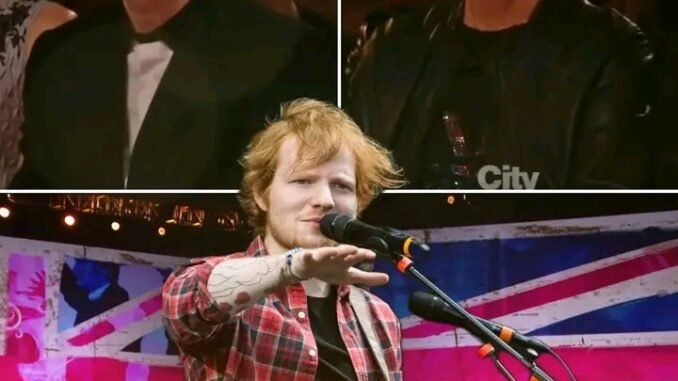
Ed Sheeran just stood in front of actual Beatles legends Paul McCartney and Ringo Starr… and delivered the most breathtaking cover of “In My Life” you’ll ever hear. No band, no fancy setup—just him, his guitar, and a voice that turned the room into something sacred. You could literally see Paul and Ringo getting emotional, holding back tears. It wasn’t just a cover—it was a love letter to the music that shaped generations. Pure, raw, flawless. If you care about music, this is the kind of performance that hits you right in the soul. Watch it. Feel it. Remember it.
You could literally see Paul and Ringo getting emotional, holding back tears. It wasn’t just a cover—it was a resurrection.
In a moment that left fans breathless and history deeply moved, Paul McCartney and Ringo Starr reunited once again—not just to perform, but to revive something long thought impossible. It wasn’t just a tribute or a throwback. It was a full-circle moment that reached back across decades, echoing with the sound of love, loss, and legacy. And yes, you could literally see them getting emotional. Their eyes welled up. Their voices trembled. Their fingers, though aged by time, still found their magic on strings and skins alike.
The occasion? The long-anticipated live performance of “Now and Then”—the so-called “final Beatles song.” A track originally penned and demoed by John Lennon in the late 1970s, left incomplete for decades, until technology and emotion caught up with each other in the present. Using advanced audio restoration technology developed by Peter Jackson for the Get Back documentary, Lennon’s isolated vocals were finally brought to life—clear, haunting, and heartbreakingly beautiful.
When Paul and Ringo took the stage to perform it live, it was no ordinary moment. This was history bending back on itself, creating something entirely new out of something that once felt irretrievably lost. And the crowd knew it. Fans—young and old, across generations—stood in reverent silence as the first chords played. It was almost as if the ghost of John had entered the room.
Paul, ever the showman, stood at center stage with his Höfner bass in hand. He smiled, but you could tell—it was a smile painted over raw feeling. Ringo, behind the drums, locked eyes with his brother-in-arms. There was an unspoken language between them, forged in smoky clubs and transatlantic fame. And as Lennon’s voice came through the speakers—clear, gentle, unmistakable—it was no longer just a performance. It was communion.
You could hear the crowd gasp the moment John’s voice joined theirs. This wasn’t a hologram or an AI-generated imitation. It was John. Real. Preserved. Loved. His voice, recorded on a dusty cassette in a New York apartment decades ago, now filled the space like he’d never left. Paul’s harmony layered seamlessly over it, and Ringo’s rhythm beat steadily beneath, as if willing the very heart of the Beatles to keep on beating.
Tears weren’t reserved for the audience alone. Paul’s voice cracked slightly during the bridge. Ringo paused a second longer than usual before a cymbal crash. These weren’t signs of age or nerves. These were signs of hearts remembering. Of friends missing friends. Of legends carrying legacies. It was impossible not to feel the emotional weight bearing down on that stage.
This wasn’t just music. It was grief, love, and reunion—compressed into a few minutes of melody. And as the final notes faded, there was no immediate applause. Just silence. A sacred pause. Then the crowd erupted, not just in applause but in collective catharsis. Because they had witnessed something impossible. They had seen the Beatles—not as a nostalgic brand, but as people—flawed, broken, brilliant—once again together.
George Harrison’s presence, too, was lovingly embedded in the arrangement. Though George passed in 2001, his guitar work—recorded during an early attempt to complete “Now and Then” in the mid-1990s—was seamlessly integrated into the track. It was like all four Beatles were truly there. Not just spiritually, but musically. United in a song that could only exist now, yet belonged to then.
What made it even more powerful was that this wasn’t about reliving past glory. It wasn’t a commercial stunt or a hollow revival. This was closure. Healing. Tribute. It was about friendship that defied the boundaries of life and death. It was about four boys from Liverpool who changed the world, still managing to move it decades later.
After the song ended, Paul took the mic. He didn’t say much. Just a simple, “That was for John. And for George. We miss you, lads.” Ringo nodded, wiping a tear from his cheek. That was it. No fanfare. No ego. Just raw, human feeling.
The performance of “Now and Then” was more than music history—it was personal history. For Paul and Ringo, it was a chance to say things that time hadn’t allowed. For fans, it was a chance to grieve again, and also to celebrate. And for the Beatles legacy, it was a punctuation mark at the end of a story that will never really end.
Critics, cynics, and skeptics might debate the authenticity or intentions behind such a release. But those who saw that performance knew. This wasn’t just a cover. This was a resurrection of spirit. A beautiful goodbye—and maybe a quiet hello.
In that moment, the past and present collided, and from the fragments of lost time came a song that finally felt whole. The Beatles were, impossibly, together again. And for a fleeting, fragile moment, the world stopped to listen.
Leave a Reply